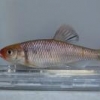I've been losing up to 5 per day with ammonia and nitrites reading zip. Plenty of oxygen in the 150 gallon circular tank they are in, serviced by 3 cubic feet of plastic media tumbling in a 55 gallon drum, and another drum preceding that which acts as a clarifier. Suspended solids are fairly low and settleable solids are removed on a regular basis.
Here's the thing: In my cool basement I heat the make up water from a well to about 81 F. From 51.6 F. in a 24 hour period. I have two drums in a tandem circuit and siphon with one packed with fiter material that removes the precipitated iron. In the past I didn't heat it that much and used a larger pump to circulate the water between the drums.
Aditionally I rerouted the pump flow from the top of the clarifier tank to the top of the moving bed biofilter vs. the bottom due to some mulm building up in the longer waterline to the bottom of the biofilter media drum.
Could the additional heating in the make up water tank, smaller circulating pump reducing the exposure of the water to air to off gas the heated water, and rerouting of water to the top of the biofilter have set my fish up to gas bubble trauma?
I've been beating my brains out trying to figure out what is stressing these fish and can't come up with anything else.
My source is a very reputable source and I had no problems the last time I got fish from them.
Thoughts?
Edited by az9, 26 August 2015 - 09:04 PM.









